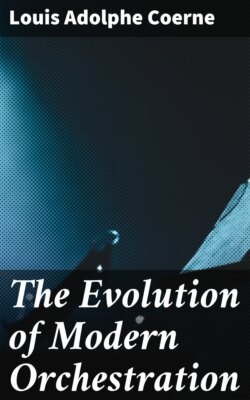Читать книгу The Evolution of Modern Orchestration - Louis Adolphe Coerne - Страница 12
На сайте Литреса книга снята с продажи.
I.
ОглавлениеTable of Contents
The awakening interest for instrumental music received its incentive from two distinctive sources—the organ, and accompaniment to solo singing. As a natural corollary to centuries of ecclesiastical supremacy in musical composition, the organ had taken first rank among instruments and was, comparatively speaking, the most advanced, both as to mechanical construction and correlative technique of its performers. Hence the organ was destined to become a spontaneous yet covert connecting link between pure choral and pure instrumental music.
The initiative in this progression is due to the direct heirs of the Flemish School—the Venetian organists. Both Andreas Gabrieli (1510), pupil of Willaert, and Merulo (1533) had begun to add ornamental embellishments to their accompaniments, and although coherence was lacking, the step once taken led to extended experiments. Thus the treatment of further instruments employed in religious worship instinctively received more careful attention. Little by little composers awoke to the realization that the servile imitation of a capella polyphonic choral writing hitherto employed, was unsuited to the characteristics of differentiated individual instruments or combinations of instruments. True, the artistic value of these early attempts was but small, and would almost appear as an incompatibility, taking into consideration the fact that their authors were erudite in the subtleties of canonical device. Nevertheless, several tangible results are to be noted. As has been said, instrumental writing acquired a certain amount of individuality. Through search for balance of tone there was inaugurated a selective process as to the permanent value of each specific genre of an instrument. Instrumental adaptation of choral imitation led to contrast. Expansibility of musical thought was quickened. Thus Flemish influence was kept alive in that the incipient forms of their Venetian disciples, inherited by the subsequent violinist-composers, matured into the cyclic sonata.
Conspicuous are the organ works of Frescobaldi (1583-1644), the great predecessor of Bach. His labors also directly influenced subsequent clavier music as developed by Kuhnau in the following century. Credit is due to Giovanni Gabrieli (1587) for systematic attempts at orchestration and a distinctive style of writing for the violin. This latter, however, had to wait for the development of technique, which, as we shall see, was concurrent with the progress of solo singing. And thus the year 1600, epoch-making in the rehabilitation of the drama, can be likewise referred to as a general starting point for independent instrumentation.
